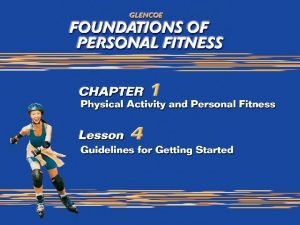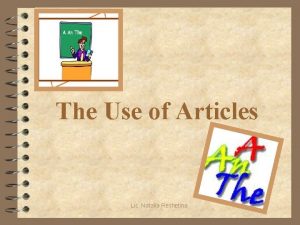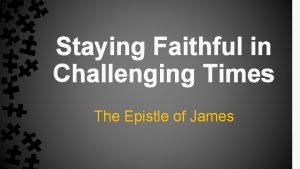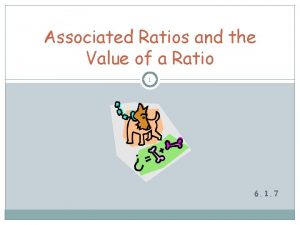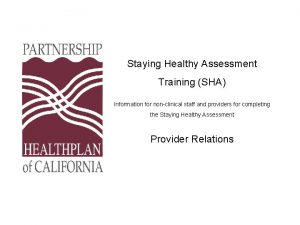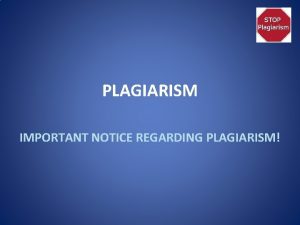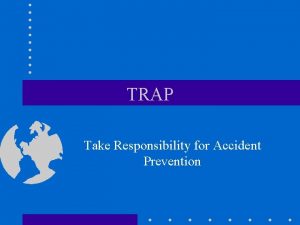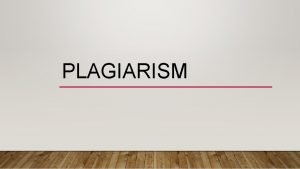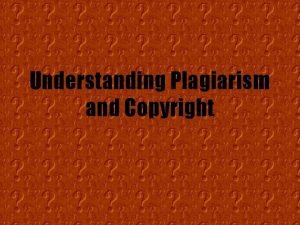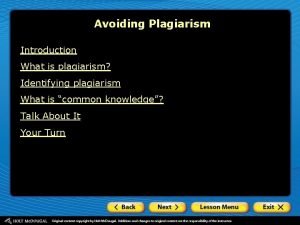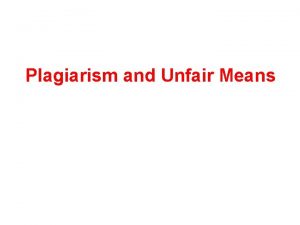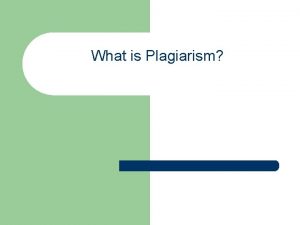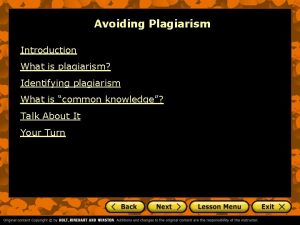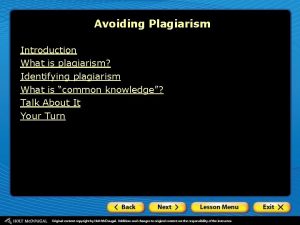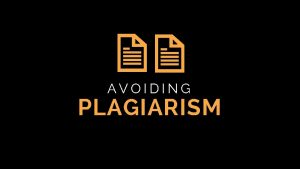Staying Out of the Plagiarism Trap Staying Out
















- Slides: 16

Staying Out of the Plagiarism Trap

Staying Out of the Plagiarism Trap Overview 4 What is plagiarism? 4 Why is it wrong? 4 Benefits of giving credit to sources 4 When to give credit 4 Ways to credit sources

What is plagiarism? Plagiarism: Taking the ideas, writings, etc. from another and passing them off as one’s own.

Levels of Plagiarism (chart taken from Purdue OWL at http: //owl. english. purdue. edu) Buying, stealing, or borrowing a paper Hiring someone to write your paper Using the source too closely when paraphrasing Building on someone’s ideas without citation Copying from another source without citing (on purpose or by accident) Deliberate Plagiarism Possibly Accidental Plagiarism

Why is plagiarism wrong? Plagiarism is a combination of stealing (another’s words) and lying (claiming that the words are one’s own)

Why is plagiarism wrong? 4 Plagiarism also shows disrespect for the entire academic system. 4 Plagiarism says that you only intend to gain your “education” by fraudulent means.

What could happen if I plagiarize? 4 An “F” on the assignment 4 Failing the course 4 Expulsion from school 4 Other disciplinary measures 4 Legal measures (in the commercial world)

SOLUTION: 4 GIVE CREDIT to the sources you consult!

Benefits of Giving Credit 4 Strengthens your writing 4 Reveals that you have done research 4 Shows you are aware of others’ positions on the topic

When to Give Credit. . . 4 When you use or refer to 4 When you use any facts, someone else’s words, ideas, theory, or opinions 4 When you use info from a magazine, book, newspaper, song, TV program, movie, Web page, computer, program, letter, advertisement, or any other medium diagrams, illustrations, charts, pictures, statistics 4 When you use information from interviewing a person 4 When you use ideas that others have given you in conversations or email

When to Give Credit No Need to Give Credit. . . 4 When you are writing your 4 When you are writing own thoughts, experiences, insights, observations, conclusions 4 When you are using “common knowledge” (folklore or common sense observation) generally accepted facts 4 When you are writing up your own experimental results

Ways to Credit Sources 4 In-text citations 4 Footnotes 4 Bibliography/Works Cited/ or Reference Page Within your text: 4 Quotation marks 4 Indirect Quotations 4 Paraphrasing

Strategies for Avoiding Plagiarism QUOTATIONS 4 In your notes, mark everything that is someone else’s words with a big “Q” 4 Put everything that comes directly from the text in quotation marks 4 Use brackets to show added phrases and ellipses to show omitted text

Strategies for Avoiding Plagiarism PARAPHRASING 4 In your notes, summarize without looking at the original passage 4 Check for accuracy and mistakenly borrowed phrases 4 Begin your summary by giving credit to the source 4 Check to make sure sentence structure and words are different from original

Staying Out of the Plagiarism Trap 4 Plagiarism is stealing Remember. . . others’ ideas or words and lying to claim them as your own 4 Strengthen your writing by giving credit when you borrow others’ ideas, words, etc.

References Avoiding Plagiarism. (2002). Retrieved July 5, 2002, from Purdue University Online Writing Lab (OWL) Web site: http: owl. english. purdue. edu/handouts/print/research/r-plagiar. html. Harris, R. (March 7, 2002). Anti-Plagiarism Strategies for Research Papers. Retrieved July 5, 2002, from http: //www. vurtualsalt. com/antiplag. htm. Hinchliffe, L. (May 1998). Cut-and-Paste Plagiarism: Preventing, Detecting and Tracking Online Plagiarism. Retrieved July 4, 2002, from http: alexia. lis. uiuc. edu/~janicke/plagiary. htm. Plagiarism: What It Is and How to Recognize and Avoid It. (2002). Retrieved July 5, 2002 from Indiana University Writing Tutorial Services Web site: http: //www. indiana. edu/~wts/plagiarism. html.
 Trip trap trip trap over my bridge
Trip trap trip trap over my bridge One direction metaphors
One direction metaphors The behavioral-change stairway begins with staying on track
The behavioral-change stairway begins with staying on track Sha questionnaire
Sha questionnaire Nbyf uftu sfts
Nbyf uftu sfts Stay healthy assessment
Stay healthy assessment I'm staying at ___ hotel on ____ hudson river *
I'm staying at ___ hotel on ____ hudson river * Staying fat for sarah byrnes characters
Staying fat for sarah byrnes characters On leaving on staying behind analysis
On leaving on staying behind analysis Guess some
Guess some Staying faithful to god in hard times
Staying faithful to god in hard times Not to smoke sentence about staying healthy
Not to smoke sentence about staying healthy Associated ratios
Associated ratios Jason is so preoccupied with staying clean
Jason is so preoccupied with staying clean Staying healthy assessment
Staying healthy assessment V. c c
V. c c Phép trừ bù
Phép trừ bù


